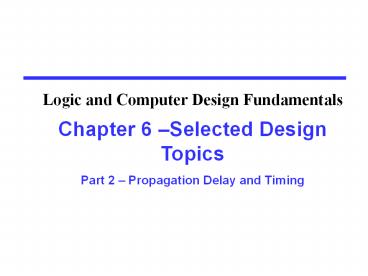Chapter 2 - Part 1 - PPT - Mano - PowerPoint PPT Presentation
Title:
Chapter 2 - Part 1 - PPT - Mano
Description:
Overview Part 1 The Design Space Part 2 Propagation Delay and Timing Propagation Delay Delay Models Cost/Performance Tradeoffs Flip-Flop Timing Circuit ... – PowerPoint PPT presentation
Number of Views:76
Avg rating:3.0/5.0
Title: Chapter 2 - Part 1 - PPT - Mano
1
(No Transcript)
2
Overview
- Part 1 The Design Space
- Part 2 Propagation Delay and Timing
- Propagation Delay
- Delay Models
- Cost/Performance Tradeoffs
- Flip-Flop Timing
- Circuit System Level Timing
- Part 3 Asynchronous Interactions
- Part 4 - Programmable Implementation Technologies
3
6-2 Gate Propagation Delay
- Propagation delay is the time for a change on an
input of a gate to propagate to the output. - Delay is usually measured at the 50 point with
respect to the H and L output voltage levels. - High-to-low (tPHL) and low-to-high (tPLH) output
signal changes may have different propagation
delays. - High-to-low (HL) and low-to-high (LH) transitions
are defined with respect to the output, not the
input. - An HL input transition causes
- an LH output transition if the gate inverts and
- an HL output transition if the gate does not
invert.
4
Propagation Delay (continued)
- Propagation delays measured at the midpoint
between the L and H values
5
Delay Models
- Transport delay - a change in the output in
response to a change on the inputs occurs after a
fixed specified delay - Inertial delay - similar to transport delay,
except that if the input changes such that the
output is to change twice in a time interval less
than the rejection time, the output changes do
not occur. Models typical electronic circuit
behavior, namely, rejects narrow pulses on the
outputs
6
Delay Model Example
A
B
A B
No Delay
(ND)
a
b
c
d
e
Transport
Delay (TD)
Inertial
Delay (ID)
Time (ns)
0
4
2
6
8
10
12
14
16
Propagation Delay 2.0 ns Rejection Time 1 .0
ns
7
Calculate Circuit Delays
- Suppose gates with delay n ns are represented for
n 0.2 ns, n 0.4 ns,n 0.5 ns, respectively
8
Calculate Circuit Delays
A
- Consider a simple
2-input
multiplexer - With function
- Y B for S 1
- Y A for S 0
- What is the delay
- of critical path?
- Glitch is due to delay of inverter
Y
S
B
0.9 ns
1.1 ns
0.2 ns
9
Fan-out and Delay
- The fan-out loading (a gates output) affects the
gates propagation delay - Example 6-1( page 324)
- One realistic equation for tpd for a NAND gate
with 4 inputs is - tpd 0.07 0.021 SL ns
- SL is the number of standard loads the gate is
driving, i. e., its fan-out in standard loads - 4-input NOR gate0.8 standard load
- 3-input NAND gate1.0 standard load
- Inverter1.0 standard load
- For SL 0.811, tpd 0.129 ns,
- What is the maximum standard loads?
- If this effect is considered, the delay of a
gate in a circuit takes on different values
depending on the circuit load on its output.
10
6-3 Flip-Flop Timing
- ts - setup time
- th - hold time
- tw - clockpulse width
- Tp- - propa-gation delay
- tPHL - High-to-Low
- tPLH - Low-to-High
- tpd - max (tPHL, tPLH)
11
Flip-Flop Timing Parameters
- ts - setup time
- the time that inputs S and R or D must be
maintained at a constant value prior to the
occurrence of the clock transition - Master-slave - Equal to the width of the
triggering pulse - Edge-triggered - Equal to a time interval that is
generally much less than the width of the the
triggering pulse
12
Flip-Flop Timing Parameters
- th - hold time
- minimum time for which the inputs must not change
after the clock transition that causes the output
to change - Often is set to zero
- tw-minimum clock pulse width to ensure that the
master has time enough to capture the input
values correctly - Tp- - propagation delay
- Same parameters as for inverter gate except
- Measured from clock edge that triggers the output
to the output change instead from the inputs
13
6-4 Sequential Circuit Timing
14
Circuit and System Level Timing
- New Timing Components
- tp - clock period - The interval between
occurrences of a specific clock edge in a
periodic clock - tpd,COMB - total delay of combinational logic
along the path from flip-flop output to flip-flop
input - tslack - extra time in the clock period in
addition to the sum of the delays and setup time
on a path - Must be greater than or equal to zero on all
paths for correct operation
15
Circuit and System Level Timing
- Timing components along a path from flip-flop to
flip-flop
16
Circuit and System Level Timing
- Timing Equations tp tslack (tpd,FF
tpd,COMB ts) - For tslack greater than or equal to zero,tp
max (tpd,FF tpd,COMB ts)for all paths from
flip-flop output to flip-flop input
17
Example 6-2
- Suppose that all the flip-flops used are the same
- tpd 0.2 ns
- ts0.1 ns
- tpd,COMB1.3 ns
- tp1.5 ns
- tslack-0.1 ns
- tp is too small
- tp gt 1.6ns
- fmax625 MHz

